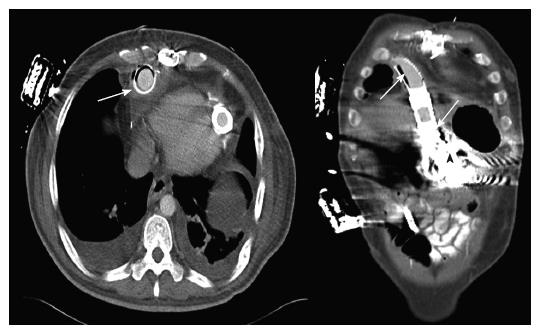Copyright
©2007 Baishideng Publishing Group Co.
World J Gastroenterol. Jun 21, 2007; 13(23): 3253-3254
Published online Jun 21, 2007. doi: 10.3748/wjg.v13.i23.3253
Published online Jun 21, 2007. doi: 10.3748/wjg.v13.i23.3253
Figure 1 Chest CT showing air at the outflow cannula of the LVAD (arrows) and inside the stomach.
Possible communication of the gastric cavity and the LVAD is shown (arrowhead).
Figure 2 A: Upper endoscopy study showing the body of the LVAD in the anterior wall of the stomach.
The perforation was concealed by the omentum and there were no clinical signs of peritonitis; B: The erosions on the metallic body of the device suggested long exposure to gastric acidic content; C: Endoscope retroflexion revealed that the LVAD had entered the stomach cavity anteriorly and close to the gastroesophageal junction.
- Citation: Yannopoulos D. Subacute gastric perforation caused by a left ventricular assist device. World J Gastroenterol 2007; 13(23): 3253-3254
- URL: https://www.wjgnet.com/1007-9327/full/v13/i23/3253.htm
- DOI: https://dx.doi.org/10.3748/wjg.v13.i23.3253










